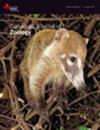新采集的和近交系Lymnaea对热应激源的行为和转录反应的比较
IF 1.1
4区 生物学
Q3 ZOOLOGY
引用次数: 0
摘要
在不同的热状态下出现的不同种群的生物对热应激的反应表现出多样性。我们使用一种旨在处理表型可塑性的“普通花园实验”方法,在Lymnaea stagnalis(Linnaeus,1758)中研究实验室近交系蜗牛(W品系)和从池塘中新鲜采集的蜗牛(Stony品系)对热休克的行为和分子反应。在世代在标准温度下饲养的W菌株中,暴露于30 °C 1 h(热休克,HS),当经历一种新颖的“味道”后,会产生一种被称为“加西亚效应”的味觉特异性厌恶。这种习得的回避需要上调热休克蛋白(HSPs)。相比之下,新收集的Stony菌株定期经历温度波动,并没有表现出加西亚效应。研究发现:(1)石蜗牛HSPs的基础mRNA水平高于W蜗牛;(2) 在W菌株中,引起加西亚效应的训练程序上调HSPs和关键的神经可塑性相关基因如CREB1和GRIN1的mRNA水平;(3) 在石蜗牛中,同样的训练程序无法改变这些靶标的mRNA水平。这些数据表明,石蜗牛并不认为HS是一种压力源,因为HSP基础mRNA水平较高,这可能会赋予更高的耐热性。本文章由计算机程序翻译,如有差异,请以英文原文为准。
Comparison of behavioural and transcriptional responses to a heat stressor between freshly collected and an inbred strain of Lymnaea
Different populations of organisms occurring across varying thermal regimes show diversity in responses to heat stress. We use a “common garden experimental” approach designed to deal with phenotypic plasticity to study in Lymnaea stagnalis (Linnaeus, 1758) the behavioural and molecular responses to a heat shock in laboratory-inbred snails (W-strain) and freshly collected snails (Stony strain) from ponds. In the W-strain, which has been reared under standardized temperatures for generations, the exposure to 30 °C for 1 h (heat shock, HS) when experienced after a novel “taste” results in a taste-specific aversion known as the “Garcia effect”. This learned avoidance requires the upregulation of heat shock proteins (HSPs). In contrast, freshly collected Stony strain, which experiences temperature fluctuations regularly, does not exhibit a Garcia effect. Here, we found that (1) Stony-strain snails have higher basal mRNA levels of HSPs than W-strain ones; (2) in the W-strain, the training procedure to cause the Garcia effect upregulates the mRNA levels of HSPs and key neuroplasticity-related genes such as CREB1 and GRIN1; (3) in Stony-strain snails, the same training procedure fails to alter the mRNA levels of those targets. These data suggest that Stony-strain snails do not perceive the HS as a stressor because of the higher HSP basal mRNA levels, which may confer a higher thermal tolerance.
求助全文
通过发布文献求助,成功后即可免费获取论文全文。
去求助
来源期刊

Canadian Journal of Zoology
生物-动物学
CiteScore
2.40
自引率
0.00%
发文量
82
审稿时长
3 months
期刊介绍:
Published since 1929, the Canadian Journal of Zoology is a monthly journal that reports on primary research contributed by respected international scientists in the broad field of zoology, including behaviour, biochemistry and physiology, developmental biology, ecology, genetics, morphology and ultrastructure, parasitology and pathology, and systematics and evolution. It also invites experts to submit review articles on topics of current interest.
 求助内容:
求助内容: 应助结果提醒方式:
应助结果提醒方式:


